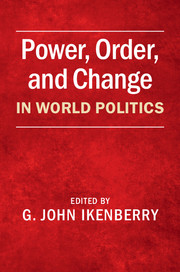Book contents
- Frontmatter
- Table of contents
- Contributors
- Acknowledgments
- Introduction: power, order, and change in world politics
- Part I Varieties of international order and strategies of rule
- 1 Unpacking hegemony: the social foundations of hierarchical order
- 2 Dominance and subordination in world politics: authority, liberalism, and stability in the modern international order
- 3 The logic of order: Westphalia, liberalism, and the evolution of international order in the modern era
- Part II Power transition and the rise and decline of international order
- Part III Systems change and global order
- Index
- References
1 - Unpacking hegemony: the social foundations of hierarchical order
Published online by Cambridge University Press: 05 September 2014
- Frontmatter
- Table of contents
- Contributors
- Acknowledgments
- Introduction: power, order, and change in world politics
- Part I Varieties of international order and strategies of rule
- 1 Unpacking hegemony: the social foundations of hierarchical order
- 2 Dominance and subordination in world politics: authority, liberalism, and stability in the modern international order
- 3 The logic of order: Westphalia, liberalism, and the evolution of international order in the modern era
- Part II Power transition and the rise and decline of international order
- Part III Systems change and global order
- Index
- References
Summary
Introduction
Since its publication over three decades ago, Robert Gilpin’s War and Change has definitively shaped scholarly debate about the rise and fall of great powers. According to Gilpin’s seminal work, the main cause of the cyclical rise and decline of hegemonic powers is the inevitable shift in the locus of power from the core to the periphery of the international system. As the gap between reigning hegemon and rising challenger closes, the order derived from hierarchy gives way to competition over position and status. A new hegemon ultimately rises to primacy, and order is again established through hierarchy. This account of systemic change has become a foundational pillar of the contemporary study of international relations.
Gilpin’s theory of international change relies exclusively on material variables. Order comes from asymmetries of power, and instability and war come when changes in the distribution of power trigger rivalry among states seeking to sit atop a new international hierarchy. Gilpin’s emphasis on the distribution of material power as the main determinant of order is in line with many other works on the subject. The field of international relations has a well-developed body of knowledge on power transitions, with most scholars joining Gilpin in focusing heavily on material variables in their analysis.
- Type
- Chapter
- Information
- Power, Order, and Change in World Politics , pp. 19 - 60Publisher: Cambridge University PressPrint publication year: 2014
References
- 16
- Cited by

